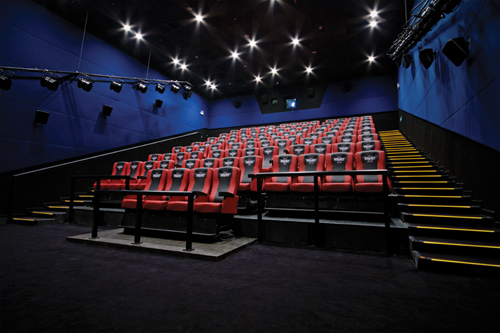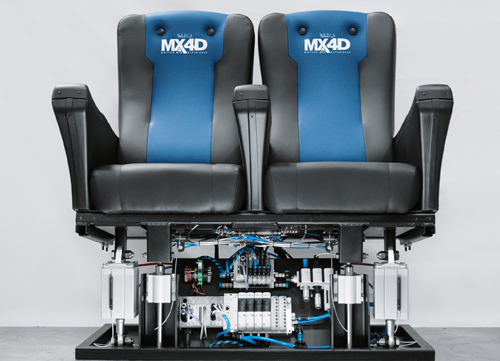
MediaMation theater seats use servopneumatics to simulate actions in films.
Experiencing films with all the senses is what cinema audiences can expect in one of the world’s 18,000 MediaMation cinema seats. With this concept, the whole body senses the movie, thanks to movements controlled by Festo’s servopneumatics and VTEM motion terminals. In essence, this provides a unique way of combining the digital world with pneumatics.
The system brings virtual reality to a new level. For example, as a chase involving sports cars unfolds on screen, the cinema seats tilt to the left in a hairpin bend – only to swing back to the right when the car straightens out. Cinemagoers feel the unevenness of the road surface and, when the driver brakes, they not only hear the screeching of the tires but also surge forward.
The cinema audience becomes one with the film. In the MX4D Motion EFX seats produced by MediaMation, an interactive-technology company based in Torrance, Calif., the audience has the feeling that they are actors themselves. The seats incline, shimmy and lift. Effects, vibrations and movements are synchronized with gusts of wind, water splashes and scents piped in through the V2 EFX armrests of the cinema seats, while pressure points are incorporated in the backs of the seats.

The Festo Motion Terminal VTEM controls all kinds of motion and triggers all the effects through the use of servopneumatics.
The IoT and Industry 4.0 are now delivering “Cinema 4.0” as the Festo Motion Terminal VTEM controls all kinds of motion and triggers all the effects. This versatile pneumatic control system integrates digital functions into piezoceramic servovalves. Preprogrammed function modules and motion apps eliminate the need for costly programming and setup, according to Festo. The proprietary motion apps “Proportional directional control valve” and “Proportional pressure regulation” control flow rates and pressures to ensure fast and powerful yet gentle and precise motion sequences.
The motion profiles for the films are processed in a CPX-CEC controller directly on Festo’s Motion Terminal. Many hardware components previously required are now superfluous. Three VTEM valves control the three actuators of each cinema seat, while one valve is responsible for pressure regulation. Inexpensive standard VUVG valves are used for controlling effects such as gusts of wind.
“The Festo Motion Terminal makes everything much easier for us. Installation, commissioning, diagnostics and fault-finding can now be realized with far fewer components,” said Dan Jamele, CEO of MediaMation.
As a key contributor to Industry 4.0, VTEM allows many new functions to be integrated thanks to digitization and piezo technology. “We already have many different apps to choose from, such as proportional pressure regulation, presetting of travel time and selectable pressure level, depending on each individual film scene,” explained Takayoshi Kawakami, director of engineering at MediaMation. Thanks to fast and precise pneumatics and intuitive operation, the concept is well received in the age of “Cinema 4.0.”
Festo
www.festo.com
Filed Under: Pneumatic Tips, Slider, Valves & Manifolds